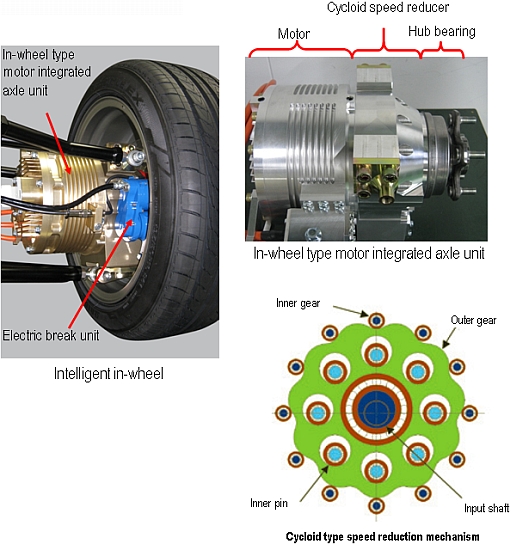
Development of the World Lightest “Intelligent In-wheel” for the Next-generation EVJune 8, 2010
This is to announce that NTN Corporation (hereafter NTN) has developed the world lightest “Intelligent in-wheel” combining “an In-wheel type motor integrated axle unit”, “Electric brake uniti” and “Multi-axis load sensorii” for the in-wheel motor type next generation EV (Electric vehicle).
By combining the in-wheel motor and the “High precision magnetic angle sensoriii” with the electric brake and information from the multi-axis load sensor, the “Intelligent in-wheel” provides optimum regenerative controliv and vehicle stability while improving fuel consumption and safety performance . Also, the in-wheel motor type EV combining various kinds of X-by-Wire with the “Intelligent in-wheel” allows for the degree of freedom in the vehicle design to increase drastically, and it becomes possible to secure motion performances corresponding to customer needs such as horizontal movement and turning by the advanced driving control. Therefore, the conventional concept for automotive vehicles changes significantly.
In recent years, the development of next generation vehicles like the EV has become an area of focus for issues related to both the environment and energy. With these issues in mind, NTN has been striving to develop an “In-wheel motor” by integrating a motor in a respective wheel. When comparing the in-wheel design to the traditional installation of a motor on the vehicle body, some advantages are that it requires a smaller amount of space for installation by using only the corner of the vehicle, and it improves in-vehicle stability through the individual control of driving force of each wheel. Some disadvantages of the in-wheel design include a reduction in operating stability due to the increase of weight underneath the suspension spring, the ride quality, and a reduction in battery life. All are major issues and weight reduction was necessary.
In order to solve those issues, NTN decided to combine a small, high speed, high output, high efficiency motor with a high reduction ratio, high speed, high load capacity speed reducer. To attain high speed, high output, and high efficiency of a small motor, design and control logic of the motor (such as loss of rotor/stator and distribution of mass) were optimized. In addition, heat generation was reduced by optimizing internal specifications and improving the efficiency; making a water-cooling system unnecessary while also providing a reduction in mass. The “Cycloid speed reduction mechanism” used in this application has the high speed characteristics of a small motor, and is capable of amplifying motor torque transmitted to the tire. Using NTN's high precision and long life rolling bearing technologies, NTN succeeded in enhancing the limits of speed and loading capacity of the cycloid speed reduction mechanism to a level suitable for the electric vehicle.
NTN is planning to introduce this new product to the market in 2012. It was exhibited at the “2010 Automotive Engineering Exposition” held in the Pacifico Yokohama during May 19th through the 21st.
Features of the Intelligent in-wheel
|
|
|---|---|
|
|
|
|
|
|
- Small actuator for electric brakes with sufficient braking force using own planetary roller screw type linear motion mechanism (Suppress pressure generating mechanism). Refer to the press release of January 25, 2008.
- Forces in three axial directions acting between road surface and wheel are detected by measuring minute strain generated on hub bearing. Refer to the press release of March 17, 2010.
- Motor rotary angle detection sensor. Down sizing was achieved by integrating the high-resolution sensor technology developed by SNR into the bearing. Refer to the press release of April 28, 2010.
SNR (France based company holds the world standard technology for ABS sensor) is a NTN's consolidated subsidiary. Refer to the press release of April 18, 2008. - Control to let a motor function as a generator to convert the motion energy into electric energy and reuse the electricity in which it creates.
- Comparison with those in the same output class (investigated by NTN)
Inquiries about this release
Photos

